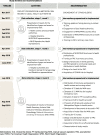Contraception and post abortion services: qualitative analysis of users' perspectives and experiences following Zika epidemic in Honduras
- PMID: 32919474
- PMCID: PMC7488691
- DOI: 10.1186/s12905-020-01066-7
Contraception and post abortion services: qualitative analysis of users' perspectives and experiences following Zika epidemic in Honduras
Abstract
Background: Zika virus (ZIKV) infection during pregnancy has severe consequences on the new-born. The World Health Organization declared the Zika outbreak to be a Public Health Emergency of International Concern (PHEIC) in 2016. Health facilities in the regions most affected by Zika lacked the capacity to respond to the increased demand for contraception. The objectives were to explore healthcare users' perceptions regarding contraception, Zika prevention during pregnancy and post-abortion care (PAC) services in the context of a Zika outbreak in Tegucigalpa, Honduras, and to follow these services over time.
Methods: This study was part of a broader implementation research study. We used qualitative research consistent with grounded theory approach. Semi-structured interviews and focus groups were performed with women and their partners who used contraceptive services or received PAC services. Data were collected in two stages from December 2017 to July 2018. Themes explored included contraception, Zika and PAC services.
Results: Participants had positive attitude towards the use of contraceptive methods and demanded more information on safety, efficacy and on side effects. Health care services were inconsistent in the provision of information on Zika and contraception services. ZIKV vector transmission was known but fewer participants were aware of risk of sexual transmission of Zika. Barriers to access healthcare services included contraceptive and PAC services included distance to healthcare facilities, disorganized admission process, long waiting times and out-of-pocket expenditure to purchase medicines. Furthermore, poor quality, mistreatment and abuse of women seeking PAC was prevalent. Some positive changes were noted over time, such as improvements in infrastructure including improved privacy and cleanliness, removal of fees, requisite to bring clean water to hospital.
Conclusions: Our results highlight the challenges and areas for improvement in policy and practice related to contraceptive services and PAC in the context of ZIKV infection. Public policies to prevent epidemics should focus more on providing proper sanitation; removing barriers to access and use of effective contraception as human rights priority. Zika epidemic has highlighted weaknesses in health systems that obstruct access to and use of sexual and reproductive health services. The study results call for increased efforts to improve access, especially for women of low socio-economic status and intervene at different levels to eradicate discrimination and improve equity in the provision of health care. Qualitative methods can capture the community perspectives and can provide useful information to develop interventions to improve services.
Keywords: Contraceptive services; Honduras; Post abortion care; Reproductive health; Zika.
Conflict of interest statement
None declared.
Figures
References
-
- Ali M, Folz R, Miller K, Johnson BR, Jr, Kiarie J. A study protocol for facility assessment and follow-up evaluations of the barriers to access, availability, utilization and readiness of contraception, abortion and postabortion services in Zika affected areas. Reprod Health. 2017;14(1):18. doi: 10.1186/s12978-017-0283-8. - DOI - PMC - PubMed
Publication types
MeSH terms
Grants and funding
LinkOut - more resources
Full Text Sources
Medical
Miscellaneous



